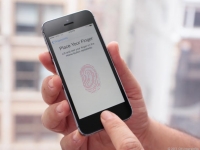The Touch ID sensor on the iPhone 5S in action.
Apple debuted its fingerprint sensor with the release of its iPhone 5S in September. Currently, the smartphone is the only Apple device that totes the security scanner. But, it looks like Apple may be looking into using biometric data to let users connect all of their devices for wireless pairing and cross-device communication.
An Apple patent application for "a system for wireless pairing and communication between devices using biometrics" went public on the US Patent and Trademark Office's Web site on Thursday. The tech giant originally applied for the patent on August 31, 2012.
The patent application explains that people typically own a handful of devices, such as a smartphone, tablet, and laptop, and oftentimes they need to securely transfer data between these devices. Apple writes that using shared biometric data between devices can be both a more secure and quicker process for users.
Here's more from the patent application:
Given the prevalence of electronic devices (such as desktop computers, mobile computing devices, portable data storage devices, smart phones, digital music players, and so on) that store data in the modern world, many users may own and/or utilize more than one such electronic device. As such, users may need to wirelessly transfer data (such as music files, preference files, configuration files, document files, movie files, image files, and so on) back and/or forth between the storage media of various such electronic devices in order to make full use out of the electronic devices. In order to control the use of such electronic devices and/or the security of data stored by such electronic devices, electronic devices may need to perform one or more 'pairing' operations before data transfer can be performed. However, in order to provide access control and/or security, such pairing processes may be time consuming and/or otherwise burdensome for users.
In the patent application, Apple lists several examples of when biometric data sharing between devices could be helpful. For instance, a user could have both a laptop and smartphone hooked up with the same biometric data and then be able to configure the devices to sync various folders, like music and photos, when the devices are within range of each other.
Apple doesn't specify what kind of biometric data it wants to use, but rather lists ideas such as fingerprint sensors, palm prints, face recognition, retina scans, and voice signatures. Also, Apple says users could have the option of giving certain folders or applications higher security levels, which would mean more than one type of biometric authorization.
Since applying for this patent, the company has released its iPhone 5S, which comes with a fingerprint security sensor called the Touch ID. Using such biometric authorization relegates the need for passcodes to the past. While Touch ID has proven to be secure for most users, it's said to be sensitive to sweat and some hackers have claimed they were able to bypass the fingerprint security system.
Apple isn't the only company working on biometrics. Samsung just unveiled its Galaxy S5 smartphone that comes with a fingerprint sensor and the HTC One Max also has the feature. Additionally, several laptops come with fingerprint scanning.

